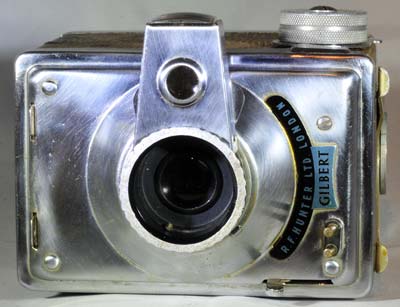Hunter Gilbert
Specification


| Manufacturer | : | R.F. Hunter |
|---|---|---|
| Produced | : | 1953 |
| Classification | : | Medium Format |
| Body Type | : | Box |
| Construction | : | Metal |
| Film Type | : | 120 |
| Film Width | : | 62mm |
| Image Size | : | 2¼ x 3¼ in |
| No. of Images | : | 8 |
| Lens Type | : | Meniscus |
| Focus Type | : | Fixed |
| Focal Length | : | 105mm |
| Focus Range | : | 8ft to inf. |
| Aperture Type | : | Variable stops |
| Aperture | : | f/11, f/16 |
| Shutter Type | : | Rotary |
| Shutter Speeds | : | B,I(1/30 sec and 1/50s) |
| Size (w x h x d) | : | 90 x 120 x 135 mm |
| Weight | : | 674g |
Art Deco Credentials
![]()
![]()
![]()
Noteworthy: Worth giving special attention
- Produced after the main Art Deco period;
- Futuristic design;
- Trapezoidal and circular design elements;
- Stainless steel front and back;
- Snake skin body;
Description
The Hunter Gilbert is a British-made box camera with an unusual apperance. It was introduced in 1953 by R. F. Hunter, Ltd., a London distribution company that sold cameras under its own brand as well as those of other companies. The Gilbert is made of stainless steel wrapped in snake skin. The lens and viewfinder are formed in a single piece which can be rotated for changing between portrait and landscape.
The camera has a 105mm f/11 lens. There are two metal tabs located above the lens. The left side tab (when looking into the lens) controls the aperture with two settings: "sunny" (f/16) and "dull" (f/11). The tab on the right switches between the two shutter speeds "fast" (1/50) and "slow" (1/30). Flash sync posts are provided on the front. The film advance knob operates a latching system that prevents double exposure. A catch under the film advance knob holds the two parts of the camera together. A red window can be found on the back of the camera while a tripod socket is located on the bottom.
The gilbert camera is described by the manufacturers as "The family holiday camera as suitable for Junior as for father. Success with simplicity. Has features never before incorporated in such a low-priced camera. Fine quality lens, two-speed shutter, no double exposures, all-metal body, 8 pictures on standard 120 roll film. Crocodile and polished chrome finish. British and best. Price Only £3-11s-11d Tax paid"
How to Use
This camera takes 120 film which is easily available.
When using the slow shutter speed(1/30s) and perhaps even at 1/50s, it is advisable to use a tripod to get clear shake free images. However, holding it against a wall or other solid object would work as well. For quick snapshots, hold it firmly against your body.
If you don't want to bother with an exposure meter, follow the guide shown. It is based on the 'Sunny 16' rule. Film is so forgiving and will produce acceptable results even when overexposed by 2 or 3 stops or underexposed by 1 stop.
The tables assume that the sun is at least 30 degrees above the horizon - that's 10am - 5pm on a summers day (May - August) in the UK.
Remember that the exposure guide in the manual may not be helpful as it is based on the use of old film with a low ISO value.
Using ISO 100/125 film - shutter speed 1/50s
| Weather Conditions | Shadow Detail | Aperture | Exposure |
|---|---|---|---|
 Sunny SunnySnow/Sand | Dark with sharp edges | f/16 | +1 Stops Overexposed Acceptable |
 Sunny Sunny | Distinct | f/16 | Good |
 Slight Overcast Slight Overcast | Soft around edges | f/11 | Good |
 Overcast Overcast | Barely visible | f/11 | -1 Stop Underexposed Acceptable |
 Heavy Overcast Heavy Overcast | None | f/11 | -2 Stops Underexposed Not Acceptable |
 Open Shade Open Shade/Sunset | None | f/11 | -3 Stops Underexposed Not Acceptable |
Using ISO 100/125 film - shutter speed 1/30s
| Weather Conditions | Shadow Detail | Aperture | Exposure |
|---|---|---|---|
 Sunny SunnySnow/Sand | Dark with sharp edges | f/16 | +2 Stops Overexposed Acceptable |
 Sunny Sunny | Distinct | f/16 | +1 Stops Overexposed Acceptable |
 Slight Overcast Slight Overcast | Soft around edges | f/16 | Good |
 Overcast Overcast | Barely visible | f/11 | Good |
 Heavy Overcast Heavy Overcast | None | f/11 | -1 Stops Underexposed Acceptable |
 Open Shade Open Shade/Sunset | None | f/11 | -2 Stops Underexposed Not Acceptable |